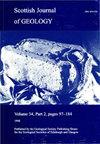苏格兰斯凯岛ruha nam Brathairean (Brothers ' Point)的蜥脚类动物占主导地位的足迹
IF 0.5
4区 地球科学
Q4 GEOLOGY
引用次数: 11
摘要
中侏罗世恐龙化石极为罕见,但苏格兰斯凯岛的新发现正开始填补这一空白。我们在这里描述了在斯凯岛ruha nam Brathairean (Brothers’Point)的Great estuary Group的Lealt页岩组(Bathonian)中发现的一个新的恐龙足迹。该遗址保存了大量小型蜥脚类恐龙的手印和足印,以及一些孤立的、破碎的中型到大型三趾类恐龙脚印。主要场地位于单一水平的泥质石灰岩上,形成于泻湖环境中。根据足迹的狭窄范围、足趾的数字特征以及手足与足趾之间异足的比例,初步将这些蜥脚类动物的足迹归属于短爪目。在一些三趾动物的足迹中推断出兽脚亚目足迹的痕迹,其中有几个表明了鱼分类单元的特征。这个新的遗址加强了先前的推断,该推断最初是基于先前在斯凯北部Duntulm城堡(Duntulm组)附近发现的地点,即中侏罗纪时期蜥脚类动物习惯在泻湖中生活。补充资料:轨道BP2_40的摄影测量模型以及相关的元数据和照片可在https://doi.org/10.6084/m9.figshare.c.4046390上获得本文章由计算机程序翻译,如有差异,请以英文原文为准。
A sauropod-dominated tracksite from Rubha nam Brathairean (Brothers’ Point), Isle of Skye, Scotland
Middle Jurassic dinosaur fossils are exceedingly rare, but new discoveries from the Isle of Skye, Scotland, are beginning to fill this gap. We here describe a new dinosaur tracksite found in the Lealt Shale Formation (Bathonian) of the Great Estuarine Group at Rubha nam Brathairean (Brothers' Point) on Skye. The site preserves an abundance of small sauropod manus and pes prints and several isolated and broken medium-to-large tridactyl footprints. The main site occurs on a single horizon of shaley limestone that formed in a lagoonal environment. The sauropod tracks are tentatively assigned to the ichnotaxon Breviparopus due to the narrow gauge of the trackways, the digital characteristics of the pes, and the ratio of heteropody observed between the manus and the pes. A theropod trackmaker is inferred for some of the tridactyl impressions with several indicative of the ichnotaxon Eubrontes. This new site strengthens the inference, originally based on a previously discovered locality near Duntulm Castle (Duntulm Formation) in northern Skye, that sauropods habitually spent time in lagoons during the Middle Jurassic. Supplementary material: The photogrammetric model of track BP2_40 and associated metadata and photographs are available at https://doi.org/10.6084/m9.figshare.c.4046390
求助全文
通过发布文献求助,成功后即可免费获取论文全文。
去求助
来源期刊

Scottish Journal of Geology
地学-地质学
CiteScore
1.70
自引率
0.00%
发文量
10
审稿时长
>12 weeks
期刊介绍:
Although published only since 1965, the Scottish Journal of Geology has a long pedigree. It is the joint publication of the Geological Society of Glasgow and the Edinburgh Geological Society, which prior to 1965 published separate Transactions: from 1860 in the case of Glasgow and 1863 for Edinburgh.
Traditionally, the Journal has acted as the focus for papers on all aspects of Scottish geology and its contiguous areas, including the surrounding seas. The publication policy has always been outward looking, with the Editors encouraging review papers and papers on broader aspects of the Earth sciences that cannot be discussed solely in terms of Scottish geology.
The diverse geology of Scotland continues to provide an important natural laboratory for the study of earth sciences; many seminal studies in geology have been carried out on Scottish rocks, and over the years the results of much of this work had been published in the Journal and its predecessors.
The Journal fully deserves its high reputation worldwide and intends to maintain its status in the front rank of publications in the Earth sciences.
 求助内容:
求助内容: 应助结果提醒方式:
应助结果提醒方式:


